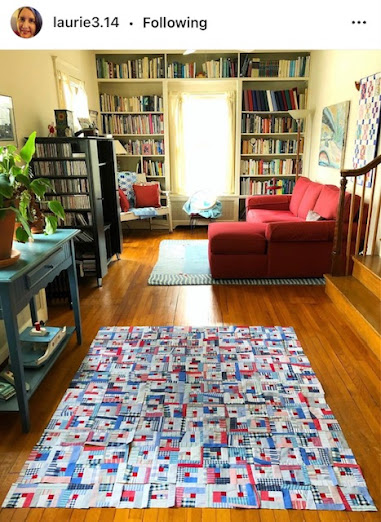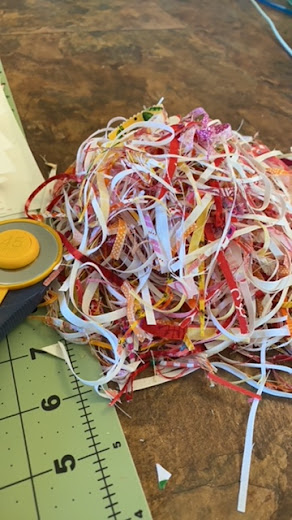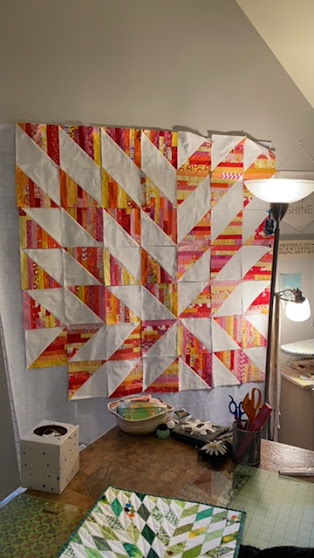Hi, all!Welcome to another session of String Therapy! Today we're going to explore that most wonderful of things, your "happy place".

For me, that is most often the beach. I would rather be at the beach than almost anywhere, and it is our favorite choice for vacation. Something about the sound of the waves, the warm sun, the laidback-ness of it all - if you ask my husband what time it is when we are at the beach, his response is always "I don't know, and I don't care!"
But for my grandmother, it was her yard. She loved growing things, and her yard reflected it. She had the largest red-bud tree I've ever seen, and a rose bush that was her mother's when she was a little girl. It was always an exciting day when that bush had a rose on it. (It came long before the many-bloomed hybrid rose bushes we have now, and didn't bloom frequently.) Her yard was always a treasure trove to explore, with blooming plants tucked away in unexpected corners, creeping charlie that gave off a wonderful smell when you brushed up against it, tiny tart wild strawberries nurtured in a corner, and soft, velvety Irish moss at the foot of the pine trees. She loved to travel, but loved most getting back to her "green place" where she said her soul could rest.
I'm sure you have a happy place too - most of us do! My quilt today reflects a little bit of mine, and a little bit of my grandmother's, I think. When I wrap up in it, I feel connected to both, and that makes me happy. See? String Therapy!
*&*&*&*&*&*&*

I will preface this post by saying that this quilt tutorial is really more for a confident quilter or an adventurous beginner who can roll with the punches and incorporate any mistakes into a finished product to be proud of. It is a "seat of the pants" kind of quilt, and I'm afraid this tutorial reflects that a bit, as there are no precise measurements for people who need them. But I love this quilt and wanted to show it to you as a springboard for creativity if nothing else.
This is the picture that got my own creative juices flowing. I loved the scrappiness of it, and the diagonal flow of the quilt. As I studied it, I realized that she had a gray strip between every three strips of scraps, with a larger 5-row section of scraps running diagonally across the center. Once I saw that, I knew I could figure out how to make the quilt myself. The gray stripe gives a cohesiveness to the design, and a place for the eye to "rest", which is important in a busy quilt!
And I had the perfect fabrics for it - a box full of Latitude batik scraps that the fabulous Kate Spain had gifted me with. I've made several quilts using them, but still had a lot of strings left. So I took the cool tones and cut as many 2.5" wide strips as I could. I then cut them down into pieces of varying lengths, from around 4" to around 12", and sewed them together into a l-o-n-n-n-n-g-g-g-g strip, jelly roll style. I cut that strip into three fairly equal lengths, and sewed them together side by side to make a very long piece of fabric, 6.5" wide and who knows how long? I didn't measure - I knew if I didn't end up with enough, I could always make more. (Like I said, "by the seat of my pants"!)
Then I took 2.5" x width-of-fabric strips of my gray and sewed them together into a long strip, and added it to one side of my scrap panel. Now I'm ready to cut!
You can see in the above picture that I have laid my ruler diagonally on the fabric strip. This is how you will cut the pieces for your quilt, building the quilt diagonally from both corners until you meet in the middle. The first cut is the easiest, because you line up the tip of the ruler with the top of the gray strip and the bottom corner with the side of your ruler. It really doesn't matter which end of the strip you work from at this point, but be aware you will be alternating ends to get the right shaped pieces.

You will now work to cut the second piece from the opposite end of the strip in order to get the gray strip on the correct side of your cut piece. (Flipping the strip will also allow you to get the most pieces from your scrap strip without waste, as the angles will be correct on the opposite end for your next piece. You'll see!) The easiest way I found to be sure I was cutting correctly was to lay the piece I needed to join to above the scrap strip so I could easily see that (a) the diagonal was going the right direction and (b) the gray strip was in the correct position. For this next strip, cut the end of the strip on the diagonal in the same direction as the strip above. (see picture if that's clear as mud!) Then measure the long edge of the strip that you will be joining to and subtract 3/4" from that measurement to get the length of the SHORT side of your next strip. For example, if the long edge of your first triangle is 12", you will subtract 3/4" from that and cut the long edge of the next strip 11 1/4" long.
In the alternative, you can lay your corner on the strip face down with the stripes aligned...
...then measure in 1/4" to see where your cut should be. This is how I figured out my first piece, then measured to see the difference between the two. It worked well for the first cut, but could be problematic for the rest as your corners get larger so I recommend using the "subtract 3/4" technique.
Now, being sure your scrap strip is placed so the gray strip is on the bottom, add a short piece of gray, still 2.5" wide, to the top edge so you can cut the triangle for the opposite bottom corner of your quilt.
Use the same technique as before to cut the second corner piece. Now you have your two opposing corners!
Now, flipping your scrap strip from end to end, keep cutting pieces and adding to the quilt, working from side to side to keep the gray strip on the correct side of your addition. Work evenly so each side is the same size. When it gets near to the size you want (or you get close to running out of scraps never mind!) you'll be ready to make that larger center strip.
Add one more scrap panel strip to one side. Then create a long strip of two more rows of scraps only to add to the other side of the quilt. I highly recommend making that strip a good bit longer than you need so you can trim the quilt square easily. I had enough scraps left in my box to create this last strip easily, but if you made more of the scrap panel than you needed for the initial strips, you could always just seam-rip a row of scraps and a row of gray off to get your long 2-row strip. Once you have added the pieces and connected your top all together, you can square up the corners using a large square ruler.
And there you have it, a **mostly square** quilt top! I will warn you, the edges are all on the bias so it takes some care not to get it too out of whack. Definitely a quilt for a confident quilter, or one who doesn't get too freaked out by improvisation and learning-as-you-go!
But once it's done comes the fun part - the quilting! Because Jolene, my long arm machine, is waiting for her buddy Joe to come see if he can figure out why she started making a really strange noise, I chose to use wavy straight lines down each of the scrap strips on this quilt, working on my tabletop Juki TL98-Q. It gives it a nice texture and just enough quilting to hold it together and keep it soft and cuddly.
The colors are so much truer in these outdoor shots, too - it was a slightly overcast day which turned out to be perfect for capturing the colors well.
And I love the backing fabric I found for this quilt - the perfect shade of blue, and modern enough to match the top without being overbearing.
*&*&*&*&*&*&*
I hope you've enjoyed our little session of String Therapy this week! What kind of quilt would you make using your own happy place as an inspiration? What colors would you use?
Well, what are you waiting for? LOL!
Hugs!
Sarah
PS It's my beautiful daughter Nancy's 9 1/4th birthday! I'm so glad I can put it that way, as the other way makes me feel really old....
















































